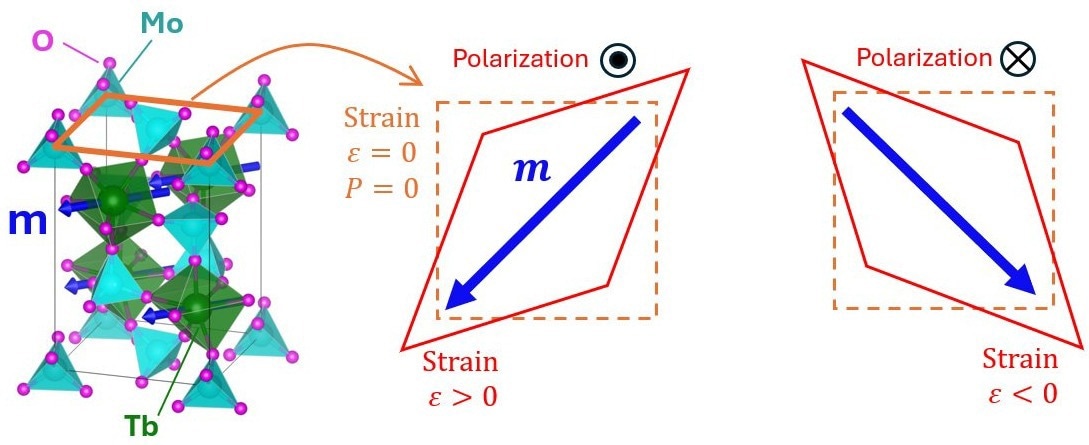Reviewed by Lexie CornerFeb 3 2025
A group of researchers at Tohoku University showed that terbium oxide Tb2(MoO4)3 functions as a multiferroic even at 160 °C. This contrasts with most multiferroics, which are limited to operating at room temperature. The research was published in the journal Communications Materials.
 A schematic illustrating the coupling between magnetization and electric polarization mediated by shear strain in Tb2(MoO4)3. The magnetization pointing in a diagonal direction elongates the crystal along it owing to the magnetoelastic coupling. Then, the electric polarization (P) is induced by the piezoelectric coupling depending on which diagonal direction the magnetization points. Image Credit: Shimon Tajima
A schematic illustrating the coupling between magnetization and electric polarization mediated by shear strain in Tb2(MoO4)3. The magnetization pointing in a diagonal direction elongates the crystal along it owing to the magnetoelastic coupling. Then, the electric polarization (P) is induced by the piezoelectric coupling depending on which diagonal direction the magnetization points. Image Credit: Shimon Tajima
Materials that lose functionality due to elevated temperatures, whether from ambient conditions or device-generated heat, have limited practical applications. This challenge is a primary limitation of multiferroic materials, which exhibit strong coupling between magnetism and ferroelectricity. Despite this constraint, the coupling effect makes multiferroics a relevant research area.
To address this limitation, the research team investigated Tb2(MoO4)3, a candidate material that demonstrated key multiferroic properties. The material maintained electric polarization control via a magnetic field at temperatures up to 160 ℃, a significant improvement over the previous threshold of approximately 20 ℃.
This advancement enhances the feasibility of multiferroics for applications in spintronics, low-power memory devices, and light-emitting diodes.
This work may pave new avenues for exploring high-temperature multiferroics.
Shimon Tajima, Institute for Materials Research, Tohoku University
The researchers achieved high-temperature multiferroic behavior by integrating two key mechanisms: the coupling between electric polarization and mechanical strain, known as the piezoelectric effect, and the coupling between mechanical strain and magnetization, known as the magnetoelastic effect.
This combination facilitated the activation of the magnetoelectric effect—the direct coupling between electric polarization and magnetization—at elevated temperatures. The magnetoelectric effect is the primary functional property of multiferroic materials.
We have succeeded in raising the working temperature of multiferroics, enabling them to operate stably at room temperature or higher. This breakthrough could lead to power-saving spintronics devices, advanced optical devices, and more.
Shimon Tajima, Institute for Materials Research, Tohoku University
Journal Reference:
Tajima, S., et al. (2024) A high-temperature multiferroic Tb2(MoO4)3. Communications Materials. doi.org/10.1038/s43246-024-00717-8.